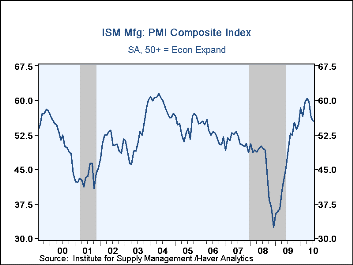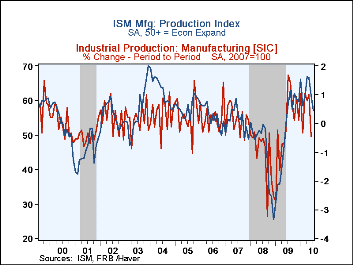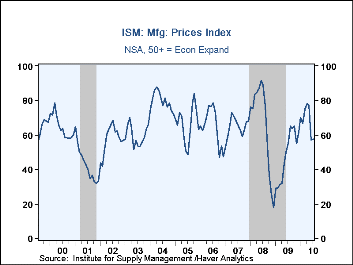 Global| Aug 02 2010
Global| Aug 02 2010U.S. ISM Index Is Lowest Since April
by:Tom Moeller
|in:Economy in Brief
Summary
The loss of forward momentum behind the factory sector's recovery is clear, though activity still is expanding. The July Composite Index from the Institute for Supply Management fell to 55.2 from 56.2 in June. The latest figure was [...]
The loss of forward momentum behind the factory sector's recovery is clear, though activity still is expanding. The July Composite Index from the Institute for Supply Management fell to 55.2 from 56.2 in June. The latest figure was higher than Consensus expectations for a reading of 54.0 but it was the third consecutive month of decline. The July level suggests expansion in factory sector activity as it is the twelfth consecutive figure above 50 and is up from the low of 32.5 reached in December '08. (Any figure above the break-even point of 50 suggests rising activity.) The ISM data is available in Haver's USECON database.
Continuing the recent pattern, declines in new orders and production were the biggest of the component series. Countering this weakness was an uptick in the employment index series to 58.6 which was off just slightly from its May high. The reading has been above 50 since December. During the last ten years there has been an 89% correlation between the ISM employment index and the m/m change in factory sector payrolls. Inventory accumulation bolstered factory sector activity with a rise in the measure after three months of decline. Finally, the pace of vendor deliveries slowed (index rose) after three months of quickening.
Activity abroad did little to offset weakness in the U.S. The export order index ticked up just slightly m/m to 56.5. That remained down sharply from its May high of 62.0 and was close to the lowest level since December. During the last ten years there has been an 88% correlation between the level of the index and the quarterly change in merchandise exports. Twenty percent of respondents reported higher export orders while seven percent reported them lower.
The separate index of prices paid held roughly steady m/m at 57.5 which was nearly the lowest level since November. Still, it remained up from the December '08 low of 18.0. Just 33% (half the recent high) of respondents reported higher prices while 18% indicated lower prices. During the last twenty years there has been an 83% correlation between the price index and the three-month change in the PPI for intermediate goods.
The ISM data are available in Haver's USECON database.
Seven Faces of "The Peril" by James Bullard, President, Federal Reserve Bank of St. Louis can be found here. The paper emphasizes that (1) The FOMC's extended period language may be increasing the probability of a Japanese-style outcome for the U.S., and (2) on balance, theU.S. quantitative easing program offers the best tool to avoid such an outcome.
| ISM Mfg | July | June | May | July '09 | 2009 | 2008 | 2007 |
|---|---|---|---|---|---|---|---|
| Composite Index | 55.2 | 56.2 | 59.7 | 49.1 | 46.2 | 45.5 | 51.1 |
| New Orders | 53.5 | 58.5 | 65.7 | 55.5 | 51.6 | 42.1 | 54.3 |
| Employment | 58.6 | 57.8 | 59.8 | 45.9 | 40.5 | 43.3 | 50.5 |
| Production | 57.0 | 61.4 | 66.6 | 59.0 | 50.4 | 45.2 | 54.1 |
| Supplier Deliveries | 58.3 | 57.3 | 61.0 | 51.7 | 51.4 | 51.6 | 51.2 |
| Inventories | 50.2 | 45.8 | 45.6 | 33.3 | 37.1 | 45.5 | 45.4 |
| Prices Paid Index (NSA) | 57.5 | 57.0 | 77.5 | 55.0 | 48.3 | 66.5 | 64.6 |
Tom Moeller
AuthorMore in Author Profile »Prior to joining Haver Analytics in 2000, Mr. Moeller worked as the Economist at Chancellor Capital Management from 1985 to 1999. There, he developed comprehensive economic forecasts and interpreted economic data for equity and fixed income portfolio managers. Also at Chancellor, Mr. Moeller worked as an equity analyst and was responsible for researching and rating companies in the economically sensitive automobile and housing industries for investment in Chancellor’s equity portfolio. Prior to joining Chancellor, Mr. Moeller was an Economist at Citibank from 1979 to 1984. He also analyzed pricing behavior in the metals industry for the Council on Wage and Price Stability in Washington, D.C. In 1999, Mr. Moeller received the award for most accurate forecast from the Forecasters' Club of New York. From 1990 to 1992 he was President of the New York Association for Business Economists. Mr. Moeller earned an M.B.A. in Finance from Fordham University, where he graduated in 1987. He holds a Bachelor of Arts in Economics from George Washington University.










